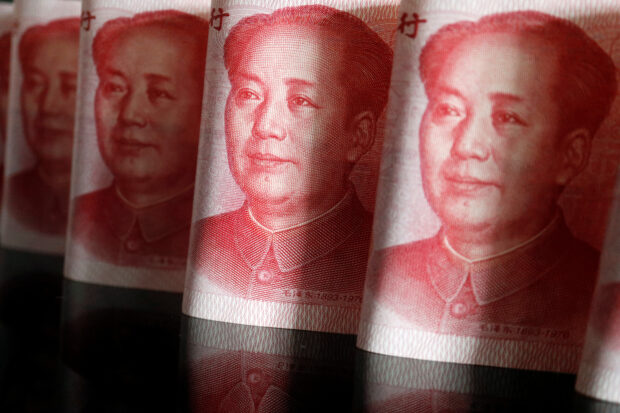China’s 2023 bank lending at record high, but economy still struggling

Chinese yuan banknotes are seen in this illustration picture taken April 25, 2022. REUTERS/Florence Lo/Illustration
BEIJING —New bank lending in China rose less than expected in December, but 2023 lending hit a new record as the central bank kept policy accommodative to support an unexpectedly shaky economic recovery.
Chinese banks extended 1.17 trillion yuan ($163.31 billion) in new yuan loans in December, up from November but falling short of analysts’ expectations, according to data released by the People’s Bank of China on Friday.
Analysts polled by Reuters had predicted new yuan loans would rise to 1.4 trillion yuan in December from 1.09 trillion yuan the previous month, and comparable with 1.4 trillion yuan a year earlier.
For the year, new bank lending hit a record 22.75 trillion yuan — roughly equivalent to the gross domestic product of the UK and up 6.8 percent from 21.31 trillion yuan in 2022 — the previous record.
Still, the world’s second-largest economy has struggled to regain traction, with a disappointing and short-lived post-COVID pandemic bounce. Consumer and business confidence remain weak, local governments are struggling under huge debts, and a protracted property crisis is weighing heavily on construction and investment.
Article continues after this advertisementREAD: China’s economy projected to slow sharply in 2024, World Bank says
Article continues after this advertisementWith demand weak, the economy is also facing persistent deflationary pressures heading into 2024, keeping alive expectations for more policy easing measures to shore up growth.
“Monetary policy will be loosened as we face deflationary pressures,” said Zong Liang, chief of research at state-owned Bank of China.
“Interest rates should be appropriately lowered given that real interest rates are relatively high.”
Other data released by China on Friday reinforced views of a highly uneven economic recovery, with exports edging up but deflationary pressures persisting amid weak domestic demand.
Next week, China will release data for December industrial output, investment and retail sales, along with fourth-quarter gross domestic product, which will give investors clues on whether the economy was able to regain some momentum heading into 2024 or will need further support.
China’s economic growth is seen hitting the official target of around 5 percent in 2023, and the government is expected to stick with that target this year.
Analysts expect the People’s Bank of China (PBOC) to unveil fresh easing steps soon to support the economy, amid concerns over deflationary pressures and questions over how long it will take the housing slump to bottom out.
READ: China 2023 GDP growth forecast cut to 5%, 4.5% in 2024 – survey
The central bank is expected to ramp up liquidity injections and cut a key interest rate when it rolls over maturing medium-term policy loans on Monday, as authorities try to get the shaky economy back on more solid footing.
But the central bank faces a dilemma as more credit is flowing to productive forces than into consumption, which could add to deflationary pressures and reduce the effectiveness of its monetary policy tools.
In 2023, household loans totaled 4.33 trillion yuan, or nearly 20 percent of the total new loans, while corporate loans amounted to 17.91 trillion yuan.
Broad M2 money supply grew 9.7 percent from a year earlier – the lowest since March 2022, central bank data showed, well below estimates of 10.1 percent forecast in the Reuters poll. M2 grew 10 percent in November from a year earlier.
Outstanding yuan loans grew 10.6 percent in December from a year earlier – hitting the lowest in over two decades, compared with 10.8 percent in November. Analysts had expected 10.8 percent growth.
Growth of outstanding total social financing (TSF), a broad measure of credit and liquidity in the economy, quickened to 9.5 percent in December from a year earlier and from 9.4 percent in November.
TSF includes off-balance sheet forms of financing that exist outside the conventional bank lending system, such as initial public offerings, loans from trust companies and bond sales.
In December, TSF fell to 1.94 trillion yuan from 2.45 trillion yuan in November. Analysts polled by Reuters had expected December TSF of 2.20 trillion yuan.